INTRODUCTION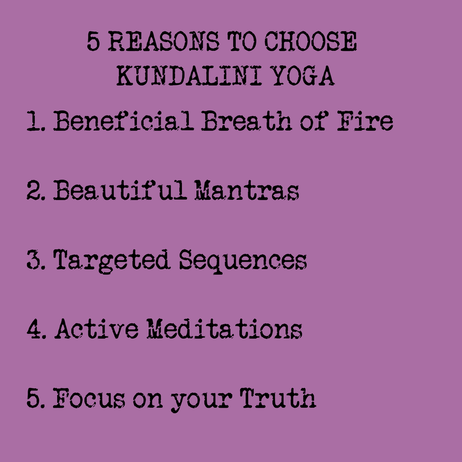 Kundalini Yoga engages me: the breath work opens me up; the mantras inspire me; the movement enlivens and challenges me; the meditations shift me; the internal, silent repetition of Sat Nam (I am Truth) brings me back to who I am again and again. The engagement is what makes it such a doable practice. If I'm not fully engaged, I'm distracted. If I'm distracted, my thoughts take over -- and that is not what I want in my spiritual practice. In this series, I explain 5 of the elements that make Kundalini Yoga an all-consuming, enjoyable, beautiful and healing practice. Each ingredient is, on its own, good for you. And together, they are a recipe for physical, mental, spiritual health and happiness. PART ONE: BENEFICIAL BREATH OF FIRE Breath of fire is a breath practice that is used throughout Kundalini Yoga. The three things I love most about it are: 1) how practicing it interrupts my churning mind, 2) how I feel a little buzzy and wonderful after a round of it, and 3) how it helps me through challenging postures. It's an activating, fueling, fast (about the speed of a panting dog), belly-moving, and audible breath, usually done through the nose. With all that going on, it's actually difficult to let the mind wander. You're in it. You're present. In addition to how it brings presence, breath of fire offers MANY tangible benefits, including:
Like everything in this practice, it's in the experience of it. So, try it (unless you are menstruating, pregnant, or fewer than three months post-partum, in which cases breath of fire is contraindicated). Here are two ways to learn or continue to move toward mastery of this awesome breath:
And you'll love it! You'll love doing it. You'll love the benefits. You'll love how it brings you in the moment. And, if you're like me, it'll help you fall in love with the practice of Kundalini Yoga. PART TWO: BEAUTIFUL MANTRAS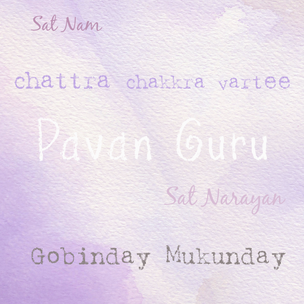 When I first began my Kundalini journey, the mantras (sacred sounds) were a strange and confusing element to me. My first teacher used to shout out Sat Nam Sat Nam Sat Nam Sat Nam Sat Nam Sat Nam Wahe Guru with no explanation. Back then, I regarded mantras as an inaccessible aspect of a powerful practice that I could just choose to tune out, and in so doing, not embrace the full “weirdness” of it all. Little did I know that mantras would enter my heart and remain there ever-available for my healing, for my soothing, for my transformation. In fact, much to my surprise, mantras became the most accessible aspect of my practice. Over the more than two decades I’ve practiced, my body and mind have been in different states. I’ve experienced minor injuries, fluctuating strength and flexibility and my mind has moved all over the spectrum from chaotic to peaceful. At times, I’ve had to pull back from a robust physical practice. At times, the mere suggestion of sitting in silent meditation will send me running away from the mat. But mantras — Sat Nam Sat Nam Sat Nam Sat Nam Sat Nam Sat Nam Wahe Guru — are always there in my consciousness, rising to the surface when needed, redirecting my distracted mind, reminding me that I am a spiritual being, and bringing a feel-good aliveness to every cell. The word mantra means mind projection, and that definition tells so much of the story. In Kundalini Yoga, we repeat sacred sounds to bring our attention to beautiful and uplifting messages and to give our bodies the experience of a higher vibration than our everyday thoughts and language achieve. We draw on an extensive cannon of mantras, which come mostly from sacred Sikh texts. Although they come from a religious tradition, these mantras are for people of all faiths. They access something deeper — heart and soul — than tenets. The above beautiful mantras, along with many others, are another tool in the toolbox of things that make Kundalini Yoga, oh-so-engaging and therefore oh-so-doable. There are three ways to work with mantras in a Kundalini Yoga practice.
Bringing mantra in in these ways has an impact. Like everything in this blog series, they add to the mix a way of staying in the moment. In addition to bringing us into presence, each mantra carries with it a specific benefit. Sat Nam, which I will discuss more in depth in Part 5 of this blog series, brings us into alignment with our authentic self. Gobinday Mukunday lists qualities of divine energy and works to cleanse the subconscious mind and break through deep-seated blocks. Chattr Chakkr Vartee speaks of divine support and helps to release fear. Pavan Guru reminds us of our life force and the nourishment of the breath. It is said to increase energy. Sat Narayan is about the sustaining force in the Universe and it serves to protect the heart and allow us to go with the flow. You can sample my favorite musical versions of each of the above mantras here. Enjoy them. Enjoy the beauty. Enjoy the effects. Enjoy that they are available to us, to make our Kundalini practice that much more meaningful, real, and high. PART 3: TARGETED SEQUENCES When we teach Kundalini Yoga, we teach from manuals and books. We don’t wing it or decide what posture we want to do when. We use prescribed sequences, called kriyas. Almost everything is delineated — how to breathe, how to arrange the body, the hands, the fingers, where to focus the eyes, and how long to do all of it. Why do we do this? Because each kriya is a special alchemy. A kriya is a series of exercises that lead to a specific effect. My teacher, Hari Kaur Khalsa, called them “divine recipes.” Each of these recipes yields a defined result. The outcomes can be physical, energetic, mental, psychological, or spiritual. Some examples of Kriyas are:
Knowing the potential benefit of a kriya adds to my engagement with my practice. When I know what I’m working toward, I’m more committed. So, this is part of my case for Kundalini. It’s another piece of the puzzle, another motivation, another point of focus, another way to go within. I don’t know how many kriyas have been recorded, but I do know that after more than 20 years of practice and 11 years of teaching, I still discover new ones. Here’s an example of a short sequence, Kriya to Experience the Original You.
To experience the original you. This kriya, in particular, motivates me. To experience the original me is one of my priorities in life. Who am I? How can I discard the junk, the baggage, the conditioning that doesn’t fit? How can I be the most confident in my most authentic self? I believe that this series of exercises would help me answer those questions. I believe it because I’ve experienced that these kriyas work, that Kundalini Yoga works. To get the full benefits of any kriya, it must be practiced every day for 40 days. It’s said that if you practice Kriya to Experience the Original You for 120 days, “you will gain great vitality, personal excellence and a new concept of who you are.” It’s about pouring yourself in, your whole self into the kriya, and trusting that this particular sequence will bring the healing it promises. Let Kundalini Yoga kriyas be a vessel for your healing. PART 4: ACTIVE MEDITATIONS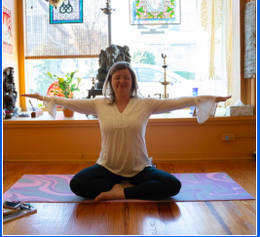 If all you know of meditation is the stereotype of “close your eyes and empty your mind,” it could feel impossible. The Kundalini approach to meditation is quite different, and in my opinion much less intimidating than other forms. Each Kundalini meditation (and there are many) has, like a kriya, a specific intention or outcome. In order to achieve the outcome, there is a combination of tools, which can include an eye focus, a breath pattern, a hand position, an arm movement, and/or a mantra. Having those tools what makes the meditations easier. The tools hold us every step of the way and keep us from straying into a torrent of thoughts. This is so key for me. See, I didn’t go into this yoga in order to meditate. I wasn’t interested in meditation or convinced of the benefits of it. I wanted to move and feel good. But as I’ve experienced these meditations and trained, I’ve become more and more interested and more and more convinced -- to the point that Kundalini Meditations have become an imperative in my life and more than that, they’ve become a reminder of magic. But I can only get to the magic by doing and I’m only willing to do what feels doable and stuff only feels doable when I know I’ll feel engaged. (This is why reorganizing my bathroom cabinets hasn’t gotten done. Not so engaging for me.) Here are some Kundalini Meditations to try that draw on tools to engage you. Meditation to Conquer Self-Animosity Draws on an eye focus, a breath pattern, and a hand position. This meditation is particularly helpful in dealing with self-sabotage. Here how:
Meditation to Experience & Project the Original Self Draws on an arm position and a mantra. Practice this meditation in order to return to your True Self.
Meditation to Open the Heart Draws on an eye focus, a mantra, and an arm movement. This meditation is for those times when you feel your heart has closed and you need to re-initiate the flow of love.
Part 5: FOCUS ON YOUR TRUTHIn Kundalini Yoga, we often focus on the mantra Sat Nam (Truth is my identity). We silently repeat it to ourselves; we chant it aloud powerfully while pulsing the navel; we stretch the sound out as we close class. In my opinion, knowing one’s Sat Nam, one’s Truth is paramount in practice and in life — more important than any other benefit we gain from coming to the mat.
Knowing our Truths is the only way we will live authentic lives and fulfill our purposes. I’m sure there are folks who had their Truths affirmed throughout their childhoods, and as they separated from their parents had the inner resources to stay with it. But I think what’s much more common is parents and society projecting onto their kids and then kids growing up not trusting their own senses of who they are. So we have Kundalini Yoga to come back to it. We have Kundalini Yoga to train our minds to not be pulled off center by our thoughts… We have Kundalini Yoga to open our hearts so that we can love who we are… We have Kundalini Yoga to get our energy flowing so that we have the energy to fuel our Truth… We have Kundalini Yoga to challenge ourselves physically and as we do, we shift; and as we shift the layers of untruth fall away… We have Kundalini Yoga & Sat Nam to reorient to our Truths. The focus on Truth is for me the most profound aspect of practicing and teaching Kundalini Yoga. It’s not just a workout. It’s not just stress relief. It’s not just increasing flexibility. It’s not just energizing. It’s the authentic trajectory of our lives. Sat Nam.
2 Comments
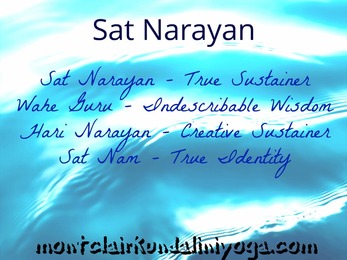 I remember packing my son Ben's lunch for his first day of preschool. I wanted it to be perfect. I put some goldfish in Tupperware. Then, I worried. What if his tiny three-year-old fingers couldn't open the container? I wouldn't be there to open it for him. What if he was too shy to ask a teacher for help? He wouldn't be able to have the comfort of his favorite snack. I cried a little as I watched this scene play out in my mind. Last week, I cried again, as I packed Ben up for his first year of college. I labeled everything meticulously. I wanted it to be perfect. I conformed completely to the what-to-pack and what-not-to-pack lists. Everything he needed. Nothing he didn't need. The day we dropped him off, we unpacked and all my planning and labeling proved worthwhile -- until something wasn't perfect. There were no hangers. We'd been told not to bring hangers. Hangers would be provided. Except they weren't. How could he embark on his college journey without hangers? We looked for someone to ask. We googled. Never mind the fact that Ben has about two things that need to be hung up. He's a T-shirt and gym shorts kind of guy. Never mind that the consequences of not having hangers are... non-existent? Ben, in his wisdom, put his hand on my shoulder, and said, "I can handle it. I'll find hangers." I looked up at him unsure, and he said, "I got it." Translation: "Mom, you gotta let go." And I did. I left him in his hanger-less dorm room to find his way. I know other parents out there can relate to the desire to control how our kids' lives go. Of course, we can't nor should we. Nevertheless, the impulse to clear the path stirs in the heart center. How can I soothe this stirring when I can't make him a meal, give him a ride, proofread his homework? As with all things, I turn to Kundalini Yoga. I've felt too unsettled over the last couple of days to sit and practice, even though I know it would help. But what I can manage from this tradition I love is mantra. The mantra that I gravitate toward in this transitional moment is Sat Narayan, the mantra for going with the flow. Now, I know that the phrase "going with the flow" sounds trivial in a hippy kind of way. But going with the flow is anything but trivial. With whatever arrives on our doorstep -- sending a child to college, moving, the death of a loved one, huge success, financial difficulty, new love, divorce, any of life's ups and downs -- if we accept what is and feel peace, we are winning the game of life. Sat Narayan guides me with its sacred vibration into that acceptance and peace, going with the flow. When I chant Sat Narayan, I connect to an undercurrent of sustenance, rivers of teachings which bypass my intellect and go right to my soul. Even if my mind is jumping and questioning and negative, if I stay with it and keep chanting, I begin to receive. I'm like a fussy baby protesting and squirming at first but with time the rocking brings deep comfort. Chanting is the rocking and rocker's heartbeat. With mantra, I soothe myself. I rely on my path, as I let Ben go to discover his own. You can find a link to samples of my favorite versions of Sat Narayan in the comments below. What mantra soothes you? Please let us know in the comments below. May we all feel sustained through all the ups and downs of life. May the truth in you guide you. Sat Nam. 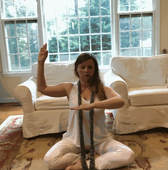 Cate discovered Kundalini Yoga by accident over 20 years ago and was surprised and thrilled by how engaged, energized, and inspired it made her feel. She's been practicing ever since. In 2008, Cate completed her Level 1 (200 hr) teacher training with Hari Kaur Khalsa of Hari NYC. In 2012, she broadened her knowledge with a very special Holistic Hatha Yoga training (300 hr) with Amy Witmyer of Sacred Space. Kundalini Yoga is her home, her go-to sanctuary, her point of peace and insight. She believes that it is a wonderful tool for busy times and busy minds. Join Cate on Sunday, Monday and Tuesday mornings for Kundalini Yoga & Meditation. |
Categories
All
|
Location127 Valley Road
Montclair, NJ |
|

 RSS Feed
RSS Feed